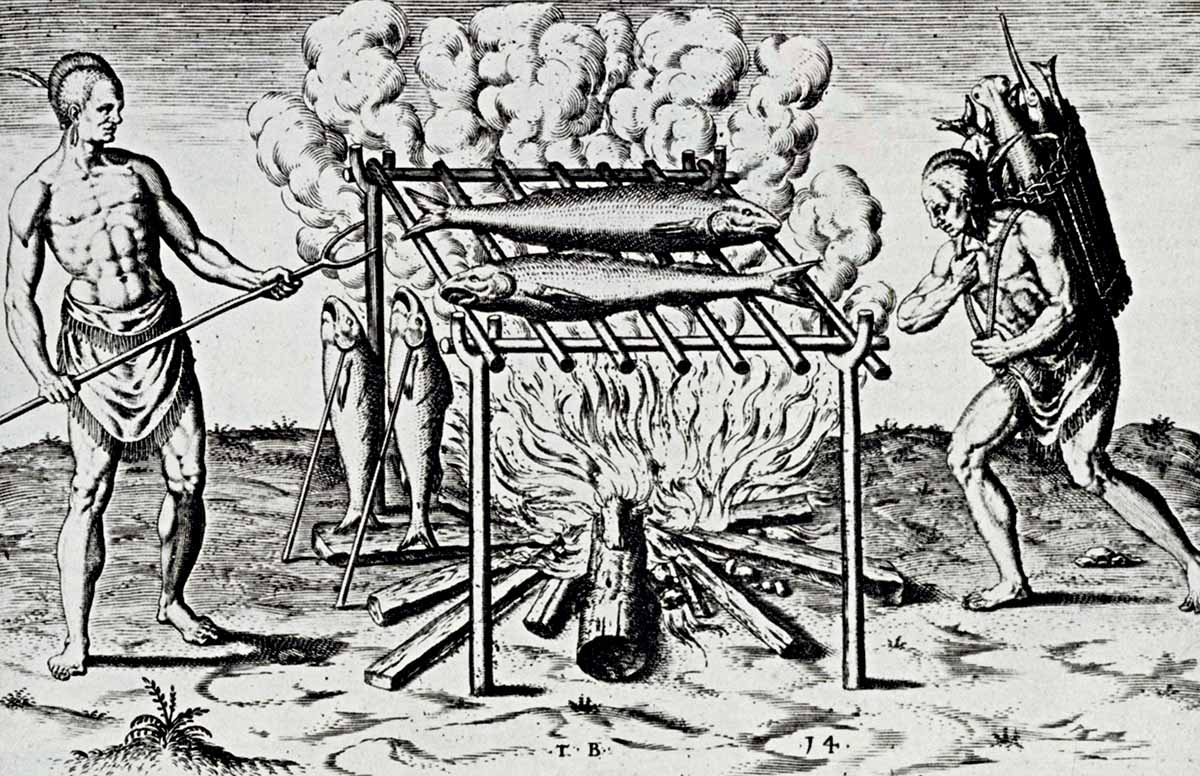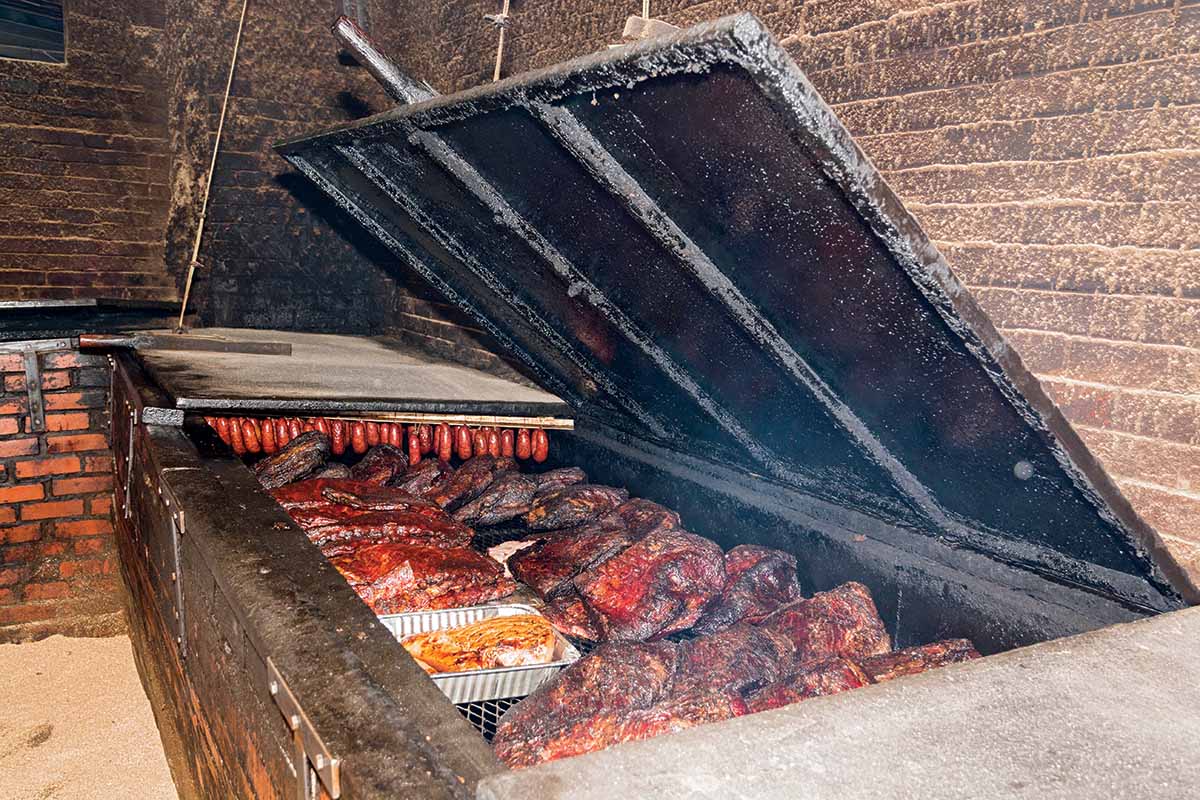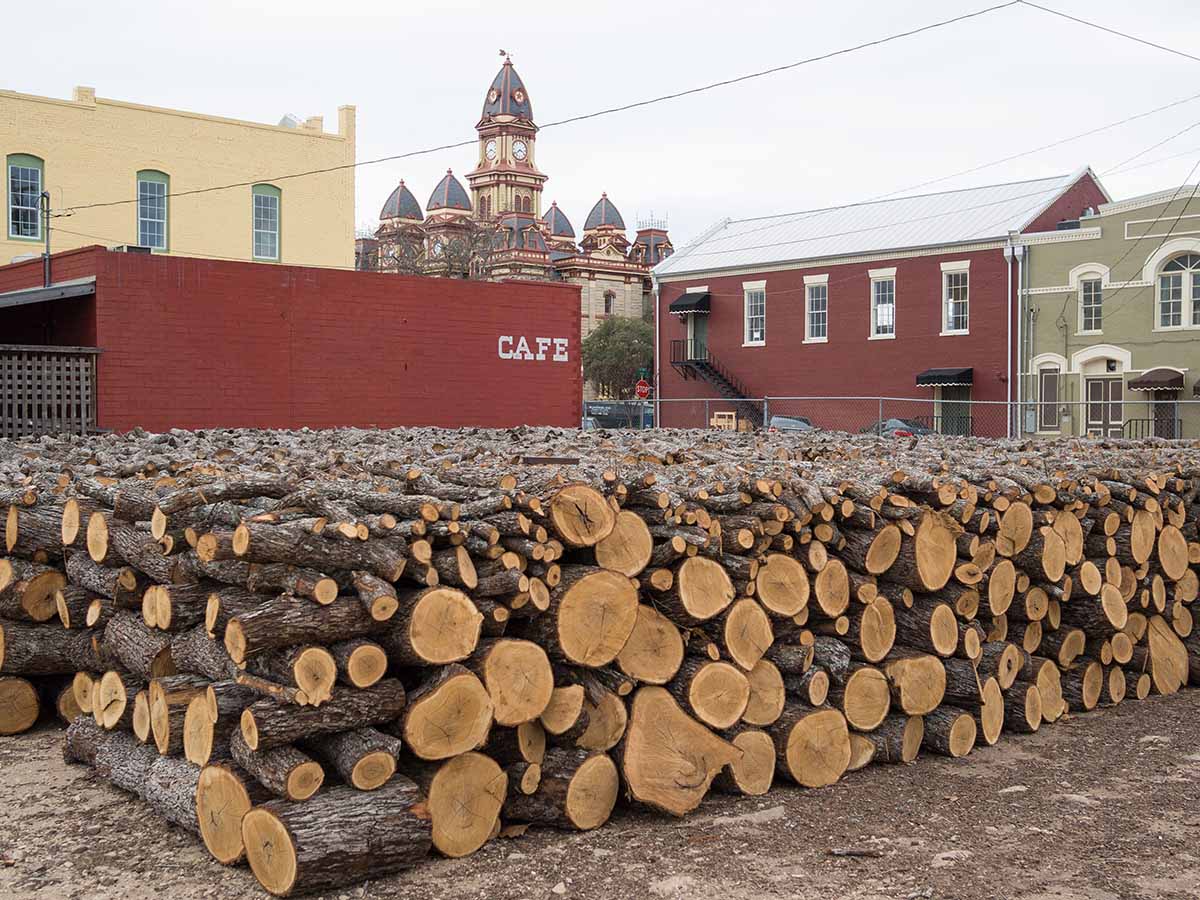The History of the Barbecue - 11 minutes read

Lockhart, Texas has plenty of reasons to feel proud. With its unique collection of 19th-century buildings, it is one of the prettiest towns in Caldwell County – and a favourite of Hollywood producers. More than 50 films have been made there, from Baby, the Rain Must Fall (1968), starring Steve McQueen and Lee Remick, to Clint Eastwood’s acclaimed drama A Perfect World (1993). But what really makes locals puff out their chests is the barbecue. Ever since Jesse Swearingen opened Lockhart’s first meat market in 1875, the town has been famous for its barbecued beef and sausages, usually served with saltine crackers, onions and pickles. Every year, its four restaurants welcome more than 250,000 diners from around the world; and in 1999, Lockhart was officially named the ‘Barbecue Capital of Texas’.
Salt, pepper, spice
The secret is in the smoke. Generally rubbed with nothing more than salt, pepper and a few spices, the meat is cooked slowly over a smouldering bed of oak and mesquite wood, often for hours at a time. This gives it a distinctively sweet, smoky flavour and makes even the toughest cuts mouth-wateringly tender. It is not the only way of barbecuing.

In San Antonio, 60 miles to the south, they slather the meat in a sticky, molasses-like dressing to keep it moist. Further to the north, in Memphis, pork shoulder is lightly seasoned and served ‘pulled’ in a sandwich with coleslaw; while in Kansas City, tomato-based sauces are de rigeur. But in Lockhart, they like to think that their way is the truly American way – and it’s easy to see why. Regardless of whether you’re eating pork, chicken or a hunk of Texas steak, the earthy taste conjures up images of a virile, honest-to-goodness frontier life, of upstanding individualism, of aspiration, of optimism and liberty.
Barbacoa
Yet while barbecues may be dear to the American soul, they are not native to the US. Instead, they trace their roots to the indigenous peoples of North and South America – and their troubled, often confusing, history says more about colonialism, war and migration than it does about freedom.
The Spanish word barbacoa was first used by the explorer and historian Gonzalo Fernàndez de Oviedo y Valdés (1478-1557). On returning to Europe after nine years in the New World, he published a series of books describing the course of his voyages and the customs of the peoples he had encountered. In La historia general y natural de las Indias (1535), he introduced his readers not only to tobacco and pineapples, but also to the barbacoa, a word he claimed to have learned from the Taínos, an Arawak-speaking people, who were the main inhabitants of Hispaniola, Jamaica and Cuba. Its meaning was, however, curious. According to Oviedo, a barbacoa was a type of lattice, made from a variety of natural materials and put to a wide range of purposes. In the Darién region of Panama, he saw Cueva sleeping in barbacoas ‘which are beds made of reeds and other wood, raised some two or three spans above the ground, because of the damp’. Elsewhere, when mahiz (maize) was harvested, the adults got boys to build rudimentary shelters from wood and cane, which they also called barbacoas. On the river Guayas, opposite Puná Island, in modern Ecuador, the natives made rafts, ‘made of fat and light sticks, like beams, and others crossed’, with their barbacoas – that is to say, their hammocks – in the middle. But if barbacoas had any culinary applications, Oviedo does not seem to have noticed them. On only one occasion did he mention a barbacoa being used for cooking and, even then, it was a rather grisly affair. One day, he reported, the governor of Cuzco, Hernando de Soto (1500-42) and his secretary entered an Inca temple, where they found a number of graves containing ‘the bodies of men roasted on a barbacoa’.
Holy smoke
Not until the mid-17th century does the word ‘barbecue’ come to be associated clearly with a method of cooking food in European texts. Yet even here the evidence is not always clear. The earliest reference appears in Beauchamp Plantagenet’s pamphlet, A Description of New Albion (1648). Describing various native peoples in North America, the author noted that the ‘Indians’ of Chesapeake Bay ‘in stead of salt doe barbecado or dry and smoak fish’. But given that the veracity – even the authenticity – of this work has been called into question, it should perhaps be treated with scepticism. More reliable is the testimony of Edmund Hickeringill (1631-1708), an eccentric English pamphleteer, who – after many strange adventures – received an appointment in the West Indies. For a time, he lived in Jamaica, which had only recently been seized from the Spanish and was still in the grip of a brutal war against the rebellious Maroons, a heterogeneous group of former slaves. While this conflict would later lead the Maroons to develop jerk (see History Today, May 2019), Hickeringill noticed that, among the native Taínos, a different method of cooking meat had emerged. Whenever they killed one of the wild hogs that inhabited the island, they would slice them open, and ‘their flesh Barbecu’d and eat’.
Such is the brevity of Hickeringill’s description that it is hard to determine exactly what this involved; but later accounts suggest that, by the late 18th century, ‘barbecuing’ referred to the process – common in the Americas – of placing meat on a lattice frame above the dying embers of a fire and cooking it slowly in the smoke. A vivid picture is provided by the African abolitionist Olaudah Equiano (c.1745-97). Although he did not use the word ‘barbecue’, Equiano reported that, during his travels in Cape Gracias a Dios (in modern Honduras), he witnessed some of the Miskito people kill an alligator and cook its meat over a hole in the earth, filled with wood which had been burnt ‘to coal’.
This method had a variety of advantages, especially for those, like the Taínos and Miskito, who lived by hunting or subsistence farming. First and foremost, it meant that nothing was wasted. Since it made even the toughest meat tender, virtually every part of an animal could be eaten. It also required little fuel; and best of all, it made for a tasty meal.
There is evidence of Europeans eating barbecue meat during this period, particularly when on manoeuvres or when travelling with native guides. And there is no doubt they enjoyed it. Such was their taste for it, in fact, that by the late 17th century, the word had already become a commonplace of English literature. In Aphra Behn’s play The Widow Ranter (1690), for example, the rabble turns against Captain Dullman, shouting ‘Let’s Barbicu this Fat Rogue’; while in Alexander Pope’s Imitations of Horace (1733-8), Oldfield, ‘with more than happy throat endued, Cries, “Send me, gods” a whole hog barbecued!’
Yet barbecuing nevertheless remained the preserve of natives and, occasionally, of slaves. There is little, if any, evidence of colonists barbecuing meat except on journeys into the interior and none whatsoever of (true) barbecues in Europe. There were two reasons for this. The most obvious is that there was simply no need to cook in the barbecue manner. If you had enough fuel and could afford the better cuts, why not simply broil or roast? More important, however, was the fact that colonial prejudices were still strong. Even as late as the mid-18th century, it was common to look down upon the indigenous peoples of the Caribbean and Central America as uncivilised; and while colonists and travellers were willing to eat barbecue meat when there was no alternative, they still regarded it as rather crude. That Behn and Pope associated it with acts of barbarity and gluttony was indicative of the disdain in which it was held.
Washington heights
Within a few decades, however, this was to change. As the prosperity and self-confidence of Britain’s North American colonies grew in the second half of the 18th century, barbecues appear to have become more common: not just among slaves, brought over from the Caribbean, but also among the colonial elites. In Massachusetts and Virginia there are accounts of barbecues held by wealthy landowners. In 1769, George Washington, for example, noted in his diary that he had gone ‘up to Alexandria for a Barbecue and stayed all Night’. Four years later, he held one of his own at Accatinck.
Given that most American colonists shared the prejudices of their English counterparts, this sudden shift is unlikely to be the result of a more positive attitude towards native culture. More probably, it was a misunderstanding. On the whole, the colonists seem to have been even less clear about what ‘barbecue’ meant than Behn and Pope. Having encountered it second-, or even third-hand, they do not appear to have recognised it as a ‘native’ term, or even as a word used to describe a method of cooking. Instead, they saw it as something like a picnic: that is, as a social gathering, usually held outdoors, at which animals were roasted whole.
It was prejudice which caused this veil of ignorance to lift. After winning independence from Britain, the former colonists were anxious not only to safeguard their freedom against foreign threats, but also to expand their territory westwards. These twin goals exacerbated their long-running conflict with the native American tribes, many of whom had allied with the British. Over the decades that followed, a series of brutal wars were fought, resulting in a programme of forced removals so severe that it has been classed as a genocide. Yet perversely, it was in perpetrating these horrors that American settlers gained a fuller understanding, not only of native society, but also of barbecuing, which, as the Irish trader James Adair noted, was a speciality of the Chickasaw. They soon realised that smoking was a method particularly well suited to the hardships of frontier life; and by the time of the Texas annexation (1845), the smell of barbecued meat (usually beef) had become as familiar a feature of pioneer towns as tumbleweed and dust.

Having been appropriated from the Native Americans, the barbecue evolved in step with the frontier. As railroads reached the townships, immigration gathered pace. A particularly large number of people arrived from Eastern and Central Europe. This not only transformed the character of frontier life; but it also revolutionised the barbecue. Settling throughout Texas and the Mid-West, Germans, Russians, Poles and Czechs each brought with them their own traditions of smoking meat and their own ideas about how barbecuing should be done. By the beginning of the 20th century, these influences had led to the emergence of different varieties, some of which still survive to this day. In Lockhart, for example, smokemasters are proud of the fact that their distinctive way of preparing sausages and ribs owes a lot to the town’s Polish heritage.
All American
Yet it was not until much later that barbecue became quintessentially ‘American’. The catalyst was the Cold War. As Kristen L. Matthews has recently argued, the United States’ uneasy relationship with the Soviet Union, coupled with fears of communist infiltration at home, raised the question of how to differentiate ‘us’ from ‘them’. The barbecue offered a tasty solution. Despite its native origins and Eastern European connections, its status as a ‘frontier’ practice allowed it to be claimed as a symbol of US exceptionalism – and, by extension, as a mark of American identity. Anyone who enjoyed barbecue meat, the logic went, must be ‘one of us’. And as it was enthusiastically adopted by the urban middle classes, it gradually acquired an association with home ownership and consumerism, which served to cement it in the popular imagination as an ‘all-American’ activity.
Since the ‘barbecue boom’ of the 1950s, it has spread to many other countries. It flourishes in the UK, is popular in Germany and is almost a national religion in Australia. But it is still unmistakably ‘American’ – and we should not forget the irony of that, least of all in today’s climate. For, while it is only natural for a town like Lockhart to take pride in its barbecue, it is high time we acknowledge that ‘the taste of liberty’ – like so much else – was taken from indigenous peoples, nurtured by immigrants and distorted by myth.
Alexander Lee is a fellow in the Centre for the Study of the Renaissance at the University of Warwick. His latest book is Humanism and Empire: The Imperial Ideal in Fourteenth-Century Italy (Oxford, 2018).